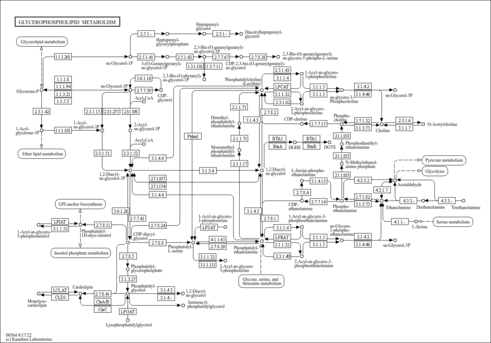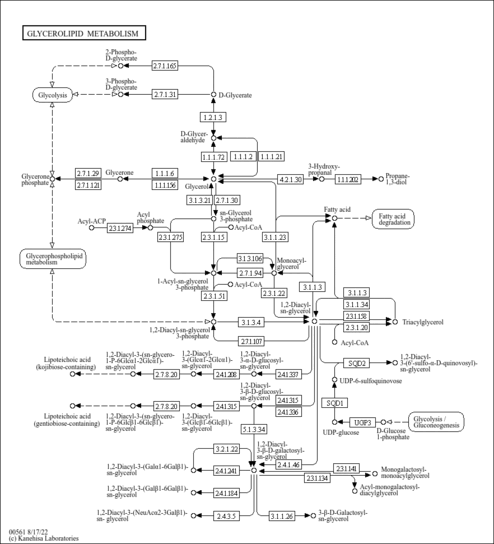| Record Information |
|---|
| Version | 5.0 |
|---|
| Status | Detected but not Quantified |
|---|
| Creation Date | 2008-09-12 01:27:12 UTC |
|---|
| Update Date | 2022-11-30 19:03:05 UTC |
|---|
| HMDB ID | HMDB0007853 |
|---|
| Secondary Accession Numbers | - HMDB0000327
- HMDB00327
- HMDB07853
|
|---|
| Metabolite Identification |
|---|
| Common Name | LysoPA(16:0/0:0) |
|---|
| Description | LysoPA(16:0/0:0) is a lysophosphatidic acid. It is a glycerophospholipid in which a phosphate moiety occupies a glycerol substitution site. Lysophosphatidic acids can have different combinations of fatty acids of varying lengths and saturation attached at the C-1 (sn-1) or C-2 (sn-2) position. Fatty acids containing 16 and 18 carbons are the most common. Lysophosphatidic acid is the simplest possible glycerophospholipid. It is the biosynthetic precursor of phosphatidic acid. Although it is present at very low levels only in animal tissues, it is extremely important biologically, influencing many biochemical processes. In particular, lysophosphatidic acid is an intercellular lipid mediator with growth factor-like activities, and is rapidly produced and released from activated platelets to influence target cells. 1-Palmitoyl lysophosphatidic acid is the major component of lysophosphatidic acid (LPA) in plasma, and is in a reduced ratio in individuals with gynecological cancers (PMID 11585410 ). LPA is a pluripotent lipid mediator controlling growth, motility, and differentiation, that has a strong influence on the chemotaxis and ultrastructure of human neutrophils (PMID 7416233 ). In serum and plasma, LPA is mainly converted from lysophospholipids, whereas in platelets and some cancer cells it is converted from phosphatidic acid. In each pathway, at least two phospholipase activities are required: phospholipase A1 (PLA1)/PLA2 plus lysophospholipase D (lysoPLD) activities are involved in the first pathway and phospholipase D (PLD) plus PLA1/PLA2 activities are involved in the second pathway. (PMID 15271293 ). |
|---|
| Structure | CCCCCCCCCCCCCCCC(=O)OCC(O)COP(O)(O)=O InChI=1S/C19H39O7P/c1-2-3-4-5-6-7-8-9-10-11-12-13-14-15-19(21)25-16-18(20)17-26-27(22,23)24/h18,20H,2-17H2,1H3,(H2,22,23,24) |
|---|
| Synonyms | | Value | Source |
|---|
| 1-Hexadecanoyl-sn-glycero-3-phosphate | ChEBI | | 1-Hexadecanoyl-sn-glycero-3-phosphoric acid | Generator | | 1-Palmitoylglycerol 3-phosphoric acid | HMDB | | 1-Palmitoyl-sn-glycerol 3-phosphate | HMDB | | PLPA | HMDB | | 1-Palmitoyl-lysophosphatidic acid | HMDB | | 1-Palmitoyl-lysophosphatidic acid, (R)-isomer | HMDB | | 1-Palmitoyl-rac-glycerol 3-phosphate | HMDB | | 1-Palmitoyl-lysophosphatidic acid, sodium salt, (R)-isomer | HMDB | | Lysophosphatidic acid(16:0) | HMDB | | 1-Palmitoyl-glycero-3-phosphate | HMDB | | 1-Hexadecanoyl-phosphatidic acid | HMDB | | LPA(16:0) | HMDB | | LPA(16:0/0:0) | HMDB | | 1-Hexadecanoyl-glycero-3-phosphate | HMDB | | Lysophosphatidic acid(16:0/0:0) | HMDB |
|
|---|
| Chemical Formula | C19H39O7P |
|---|
| Average Molecular Weight | 410.4825 |
|---|
| Monoisotopic Molecular Weight | 410.243340114 |
|---|
| IUPAC Name | [3-(hexadecanoyloxy)-2-hydroxypropoxy]phosphonic acid |
|---|
| Traditional Name | PLPA |
|---|
| CAS Registry Number | Not Available |
|---|
| SMILES | CCCCCCCCCCCCCCCC(=O)OCC(O)COP(O)(O)=O |
|---|
| InChI Identifier | InChI=1S/C19H39O7P/c1-2-3-4-5-6-7-8-9-10-11-12-13-14-15-19(21)25-16-18(20)17-26-27(22,23)24/h18,20H,2-17H2,1H3,(H2,22,23,24) |
|---|
| InChI Key | YNDYKPRNFWPPFU-UHFFFAOYSA-N |
|---|
| Chemical Taxonomy |
|---|
| Description | Belongs to the class of organic compounds known as 1-acylglycerol-3-phosphates. These are lysophosphatidic acids where the glycerol is esterified with a fatty acid at O-1 position. |
|---|
| Kingdom | Organic compounds |
|---|
| Super Class | Lipids and lipid-like molecules |
|---|
| Class | Glycerophospholipids |
|---|
| Sub Class | Glycerophosphates |
|---|
| Direct Parent | 1-acylglycerol-3-phosphates |
|---|
| Alternative Parents | |
|---|
| Substituents | - 1-acylglycerol-3-phosphate
- Fatty acid ester
- Monoalkyl phosphate
- Fatty acyl
- Alkyl phosphate
- Phosphoric acid ester
- Organic phosphoric acid derivative
- Carboxylic acid ester
- Secondary alcohol
- Carboxylic acid derivative
- Monocarboxylic acid or derivatives
- Hydrocarbon derivative
- Organic oxide
- Organic oxygen compound
- Carbonyl group
- Alcohol
- Organooxygen compound
- Aliphatic acyclic compound
|
|---|
| Molecular Framework | Aliphatic acyclic compounds |
|---|
| External Descriptors | |
|---|
| Ontology |
|---|
| Not Available | Not Available |
|---|
| Physical Properties |
|---|
| State | Solid |
|---|
| Experimental Molecular Properties | | Property | Value | Reference |
|---|
| Melting Point | Not Available | Not Available | | Boiling Point | Not Available | Not Available | | Water Solubility | Not Available | Not Available | | LogP | Not Available | Not Available |
|
|---|
| Experimental Chromatographic Properties | Not Available |
|---|
| Predicted Molecular Properties | |
|---|
| Predicted Chromatographic Properties | Predicted Collision Cross SectionsPredicted Kovats Retention IndicesUnderivatizedDerivatized| Derivative Name / Structure | SMILES | Kovats RI Value | Column Type | Reference |
|---|
| LysoPA(16:0/0:0),1TMS,isomer #1 | CCCCCCCCCCCCCCCC(=O)OCC(COP(=O)(O)O)O[Si](C)(C)C | 3104.1 | Semi standard non polar | 33892256 | | LysoPA(16:0/0:0),1TMS,isomer #2 | CCCCCCCCCCCCCCCC(=O)OCC(O)COP(=O)(O)O[Si](C)(C)C | 3094.1 | Semi standard non polar | 33892256 | | LysoPA(16:0/0:0),2TMS,isomer #1 | CCCCCCCCCCCCCCCC(=O)OCC(COP(=O)(O)O[Si](C)(C)C)O[Si](C)(C)C | 3096.9 | Semi standard non polar | 33892256 | | LysoPA(16:0/0:0),2TMS,isomer #1 | CCCCCCCCCCCCCCCC(=O)OCC(COP(=O)(O)O[Si](C)(C)C)O[Si](C)(C)C | 2944.3 | Standard non polar | 33892256 | | LysoPA(16:0/0:0),2TMS,isomer #1 | CCCCCCCCCCCCCCCC(=O)OCC(COP(=O)(O)O[Si](C)(C)C)O[Si](C)(C)C | 3745.4 | Standard polar | 33892256 | | LysoPA(16:0/0:0),2TMS,isomer #2 | CCCCCCCCCCCCCCCC(=O)OCC(O)COP(=O)(O[Si](C)(C)C)O[Si](C)(C)C | 3112.5 | Semi standard non polar | 33892256 | | LysoPA(16:0/0:0),2TMS,isomer #2 | CCCCCCCCCCCCCCCC(=O)OCC(O)COP(=O)(O[Si](C)(C)C)O[Si](C)(C)C | 2951.7 | Standard non polar | 33892256 | | LysoPA(16:0/0:0),2TMS,isomer #2 | CCCCCCCCCCCCCCCC(=O)OCC(O)COP(=O)(O[Si](C)(C)C)O[Si](C)(C)C | 3443.0 | Standard polar | 33892256 | | LysoPA(16:0/0:0),3TMS,isomer #1 | CCCCCCCCCCCCCCCC(=O)OCC(COP(=O)(O[Si](C)(C)C)O[Si](C)(C)C)O[Si](C)(C)C | 3115.8 | Semi standard non polar | 33892256 | | LysoPA(16:0/0:0),3TMS,isomer #1 | CCCCCCCCCCCCCCCC(=O)OCC(COP(=O)(O[Si](C)(C)C)O[Si](C)(C)C)O[Si](C)(C)C | 2987.7 | Standard non polar | 33892256 | | LysoPA(16:0/0:0),3TMS,isomer #1 | CCCCCCCCCCCCCCCC(=O)OCC(COP(=O)(O[Si](C)(C)C)O[Si](C)(C)C)O[Si](C)(C)C | 3263.1 | Standard polar | 33892256 | | LysoPA(16:0/0:0),1TBDMS,isomer #1 | CCCCCCCCCCCCCCCC(=O)OCC(COP(=O)(O)O)O[Si](C)(C)C(C)(C)C | 3377.9 | Semi standard non polar | 33892256 | | LysoPA(16:0/0:0),1TBDMS,isomer #2 | CCCCCCCCCCCCCCCC(=O)OCC(O)COP(=O)(O)O[Si](C)(C)C(C)(C)C | 3341.5 | Semi standard non polar | 33892256 | | LysoPA(16:0/0:0),2TBDMS,isomer #1 | CCCCCCCCCCCCCCCC(=O)OCC(COP(=O)(O)O[Si](C)(C)C(C)(C)C)O[Si](C)(C)C(C)(C)C | 3594.9 | Semi standard non polar | 33892256 | | LysoPA(16:0/0:0),2TBDMS,isomer #1 | CCCCCCCCCCCCCCCC(=O)OCC(COP(=O)(O)O[Si](C)(C)C(C)(C)C)O[Si](C)(C)C(C)(C)C | 3233.4 | Standard non polar | 33892256 | | LysoPA(16:0/0:0),2TBDMS,isomer #1 | CCCCCCCCCCCCCCCC(=O)OCC(COP(=O)(O)O[Si](C)(C)C(C)(C)C)O[Si](C)(C)C(C)(C)C | 3837.1 | Standard polar | 33892256 | | LysoPA(16:0/0:0),2TBDMS,isomer #2 | CCCCCCCCCCCCCCCC(=O)OCC(O)COP(=O)(O[Si](C)(C)C(C)(C)C)O[Si](C)(C)C(C)(C)C | 3564.2 | Semi standard non polar | 33892256 | | LysoPA(16:0/0:0),2TBDMS,isomer #2 | CCCCCCCCCCCCCCCC(=O)OCC(O)COP(=O)(O[Si](C)(C)C(C)(C)C)O[Si](C)(C)C(C)(C)C | 3206.4 | Standard non polar | 33892256 | | LysoPA(16:0/0:0),2TBDMS,isomer #2 | CCCCCCCCCCCCCCCC(=O)OCC(O)COP(=O)(O[Si](C)(C)C(C)(C)C)O[Si](C)(C)C(C)(C)C | 3609.3 | Standard polar | 33892256 | | LysoPA(16:0/0:0),3TBDMS,isomer #1 | CCCCCCCCCCCCCCCC(=O)OCC(COP(=O)(O[Si](C)(C)C(C)(C)C)O[Si](C)(C)C(C)(C)C)O[Si](C)(C)C(C)(C)C | 3825.3 | Semi standard non polar | 33892256 | | LysoPA(16:0/0:0),3TBDMS,isomer #1 | CCCCCCCCCCCCCCCC(=O)OCC(COP(=O)(O[Si](C)(C)C(C)(C)C)O[Si](C)(C)C(C)(C)C)O[Si](C)(C)C(C)(C)C | 3374.2 | Standard non polar | 33892256 | | LysoPA(16:0/0:0),3TBDMS,isomer #1 | CCCCCCCCCCCCCCCC(=O)OCC(COP(=O)(O[Si](C)(C)C(C)(C)C)O[Si](C)(C)C(C)(C)C)O[Si](C)(C)C(C)(C)C | 3474.3 | Standard polar | 33892256 |
|
|---|
| GC-MS Spectra| Spectrum Type | Description | Splash Key | Deposition Date | Source | View |
|---|
| Predicted GC-MS | Predicted GC-MS Spectrum - LysoPA(16:0/0:0) GC-MS (1 TMS) - 70eV, Positive | splash10-02n9-5940100000-a5ca92d33fddeb085287 | 2017-10-06 | Wishart Lab | View Spectrum | | Predicted GC-MS | Predicted GC-MS Spectrum - LysoPA(16:0/0:0) GC-MS (Non-derivatized) - 70eV, Positive | Not Available | 2021-10-12 | Wishart Lab | View Spectrum |
MS/MS Spectra| Spectrum Type | Description | Splash Key | Deposition Date | Source | View |
|---|
| Experimental LC-MS/MS | LC-MS/MS Spectrum - LysoPA(16:0/0:0) NA , positive-QTOF | splash10-03di-0549600000-25838221a69792238ab5 | 2020-07-21 | HMDB team, MONA | View Spectrum | | Predicted LC-MS/MS | Predicted LC-MS/MS Spectrum - LysoPA(16:0/0:0) 10V, Positive-QTOF | splash10-08fr-2986700000-f3b30f5c39843042fd11 | 2015-09-15 | Wishart Lab | View Spectrum | | Predicted LC-MS/MS | Predicted LC-MS/MS Spectrum - LysoPA(16:0/0:0) 20V, Positive-QTOF | splash10-0a4s-3942000000-0e96d3c410d5f67cbc44 | 2015-09-15 | Wishart Lab | View Spectrum | | Predicted LC-MS/MS | Predicted LC-MS/MS Spectrum - LysoPA(16:0/0:0) 40V, Positive-QTOF | splash10-0a4s-6930000000-8e619c799b8a218b3a05 | 2015-09-15 | Wishart Lab | View Spectrum | | Predicted LC-MS/MS | Predicted LC-MS/MS Spectrum - LysoPA(16:0/0:0) 10V, Negative-QTOF | splash10-0a4r-4190300000-bb83e3f01055cbe6102f | 2015-09-15 | Wishart Lab | View Spectrum | | Predicted LC-MS/MS | Predicted LC-MS/MS Spectrum - LysoPA(16:0/0:0) 20V, Negative-QTOF | splash10-004i-9050000000-de299cedb3cf89da4492 | 2015-09-15 | Wishart Lab | View Spectrum | | Predicted LC-MS/MS | Predicted LC-MS/MS Spectrum - LysoPA(16:0/0:0) 40V, Negative-QTOF | splash10-004i-9000000000-f3fc94f808e80bf00353 | 2015-09-15 | Wishart Lab | View Spectrum | | Predicted LC-MS/MS | Predicted LC-MS/MS Spectrum - LysoPA(16:0/0:0) 10V, Negative-QTOF | splash10-0a4i-0000900000-97431642e54a4a707394 | 2021-09-24 | Wishart Lab | View Spectrum | | Predicted LC-MS/MS | Predicted LC-MS/MS Spectrum - LysoPA(16:0/0:0) 20V, Negative-QTOF | splash10-0a4i-0000900000-97431642e54a4a707394 | 2021-09-24 | Wishart Lab | View Spectrum | | Predicted LC-MS/MS | Predicted LC-MS/MS Spectrum - LysoPA(16:0/0:0) 40V, Negative-QTOF | splash10-0pb9-2951500000-d6189b2a977487b10d88 | 2021-09-24 | Wishart Lab | View Spectrum | | Predicted LC-MS/MS | Predicted LC-MS/MS Spectrum - LysoPA(16:0/0:0) 10V, Positive-QTOF | splash10-03di-0000900000-61bb60154e9d7308c06d | 2021-09-24 | Wishart Lab | View Spectrum | | Predicted LC-MS/MS | Predicted LC-MS/MS Spectrum - LysoPA(16:0/0:0) 20V, Positive-QTOF | splash10-03di-0000900000-61bb60154e9d7308c06d | 2021-09-24 | Wishart Lab | View Spectrum | | Predicted LC-MS/MS | Predicted LC-MS/MS Spectrum - LysoPA(16:0/0:0) 40V, Positive-QTOF | splash10-00du-0955100000-a47b051136d1c4973480 | 2021-09-24 | Wishart Lab | View Spectrum |
|
|---|

